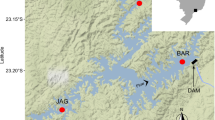Summary
Field observations suggested that benthivorous fish, causing bioturbation, are able to effect the food availability for predacious water mites feeding on bottom dwelling chironomid larvae. This hypothesis was tested in the laboratory. In an undisturbed situation the predation rate exercised by the water mites on the tube dwelling chironomid Cladotanytarsus mancus was very low. However, when the sediment was disturbed, the predation rate increased substantially. The relevance of this for the field situation is discussed.
Similar content being viewed by others
References
Backiel T, Zawisza J (1968) Synopsis of biological data on the bream Abramis brama (Linnaeus 1758), FAO Fisheries Synopsis. FAD, Rome
Dusoge K (1980) The occurrence and role of the predatory larvae of Procladius Skuse (Chironomidae, Diptera) in the benthos of lake Sniardwy. Ecol Polska 28:155–186
Eriksson MOG, Henrikson L, Oscarson HG (1980) Predator-prey relationships among water-mites (Hydracarina) and other freshwater organisms. Arch Hydrobiol 88:146–154
Kajak Z (1977) Factors influencing benthos biomass in shallow lake environments. Ekol pol 25:421–429
Kajak Z (1980) Role of invertebrate predators (mainly Procladius sp.) in benthos. In: Murray DA (ed) Chironomidae, ecology, systematics, cytology and physiology. Pergamon Press, Oxford, pp 339–348
Kerfoot WC (1982) A question of taste: Crypsis and warning coloration in freshwater zooplankton communities. Ecology 63:538–554
Laskar K (1948) Die Ernährung des Brassen (Abramis brama L.) im eutrophen See. Arch Hydrobiol 42:1–165
Paterson CG (1970) Water mites (Hydracarina) as predators of chironomid larvae (Insecta: Diptera). Can J Zool 48:610–614
Sibbing FA, Osse JWM, Terlouw A (1985) Food handling in the carp (Cyprinus carpio L.), its movement patterns, mechanisms and limitations. J Zool (in press)
Virnstein RW (1978) Predator caging experiments in soft sediments: caution advised. In: Wiley ML (ed) Estuarine interactions. Academic Press, New York, pp 261–273
Walde SJ, Davies RW (1984) Invertebrate predation and lotic prey communities: evaluation of in situ enclosure/exclosure experiments. Ecology 65:1206–1213
Author information
Authors and Affiliations
Rights and permissions
About this article
Cite this article
ten Winkel, E.H., Davids, C. Bioturbation by cyprinid fish affecting the food availability for predatory water mites. Oecologia 67, 218–219 (1985). https://doi.org/10.1007/BF00384287
Received:
Issue Date:
DOI: https://doi.org/10.1007/BF00384287




